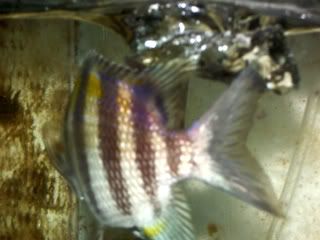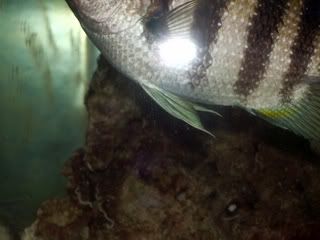"Nemo" doesn't look like A. notatus. He doesn't have a yellow tail. He is yellow on top of his body and has bluish tinged pelvic and anal fins. I tried to get a good picture, but after 50 tries, this is all I got. I found an old picture of him too. In the first picture, you can see that he is missing his pectoral fin on his right side.
At the time (2 years ago), I did a search for all the native Hawaiian damsels, and his picture did not show up, so I assumed he was a bilge baby brought in as planktonic larvae from somewhere in the Indopacific. You know, all that shipping between Hawaii and the coasts and islands of different nations. I couldn't, in good conscience, release him since I thought he was non-native to the islands; and I couldn't, in good conscience, kill him. So he got shipped to California with my other fish.
I narrowed his species down to 3 possibilities:
1. Abudefduf saxatilis-Sergeant major from Atlantic, highly unlikely.
http://fishbase.org/Photos/ThumbnailsSummary.php?ID=1119
2. Abudefduf vaigiensis- My best guess, but according to fish data base, it was replaced by A. abdominalis in the Hawaiian islands, so still not native.
http://en.wikipedia.org/wiki/Indo-Pacific_sergeant
3. Abudefduf troschelii- Another possibility since Hawaii gets alot of shipping from California, but their bars are not as thick as A. vaigiensis, and Nemo's is.
http://fishbase.org/Summary/speciesSummary.php?ID=8245&genusname=Abudefduf&speciesname=troschelii
Then today, I found this:
Abudefduf abdominalis- "The Hawaiian Sergeant probably descended from the Indo-Pacific Sergeant, A. vaigiensis, (above) a species widespread in the Indo-Pacific outside Hawai`i. Until about 1990 the Indo-Pacific Sergeant was unknown in the Islands; it has somehow been introduced (perhaps drifting in with abandoned fishing gear) and now almost always occurs in small numbers wherever the Hawaiian species is present. The two species do not appear to be interbreeding. The Indo-Pacific Sergeant sports bright yellow on its back and has longer, broader, darker bars than the Hawaiian Sergeant."
So, I guess there are now breeding populations of A. vaigiensis in the Hawaiian Islands. None of the information I looked at 2 years ago stated this. Still, I don't know if I would have or should have released him. Hawaii is very protective of their native species and very wary of introduced species. Of course this info is 2 years too late, but I'm curious- What would you have done?






